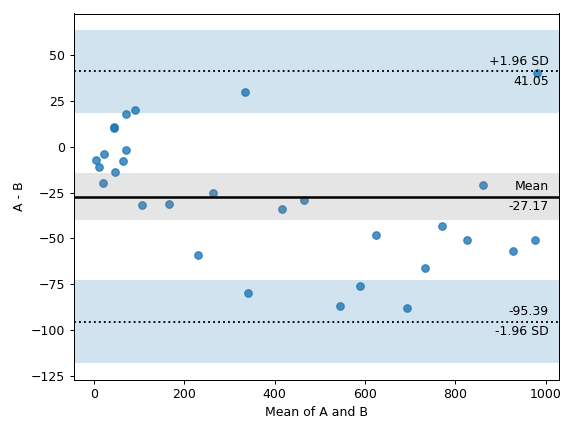pingouin.plot_blandaltman#
- pingouin.plot_blandaltman(x, y, agreement=1.96, xaxis='mean', confidence=0.95, annotate=True, ax=None, **kwargs)[source]#
Generate a Bland-Altman plot to compare two sets of measurements.
- Parameters:
- x, ypd.Series, np.array, or list
First and second measurements.
- agreementfloat
Multiple of the standard deviation to plot agreement limits. The defaults is 1.96, which corresponds to 95% confidence interval if the differences are normally distributed.
- xaxisstr
Define which measurements should be used as the reference (x-axis). Default is to use the average of x and y (“mean”). Accepted values are “mean”, “x” or “y”.
- confidencefloat
If not None, plot the specified percentage confidence interval of the mean and limits of agreement. The CIs of the mean difference and agreement limits describe a possible error in the estimate due to a sampling error. The greater the sample size, the narrower the CIs will be.
- annotatebool
If True (default), annotate the values for the mean difference and agreement limits.
- axmatplotlib axes
Axis on which to draw the plot.
- **kwargsoptional
Optional argument(s) passed to
matplotlib.pyplot.scatter().
- Returns:
- axMatplotlib Axes instance
Returns the Axes object with the plot for further tweaking.
Notes
Bland-Altman plots [1] are extensively used to evaluate the agreement among two different instruments or two measurements techniques. They allow identification of any systematic difference between the measurements (i.e., fixed bias) or possible outliers.
The mean difference (= x - y) is the estimated bias, and the SD of the differences measures the random fluctuations around this mean. If the mean value of the difference differs significantly from 0 on the basis of a 1-sample t-test, this indicates the presence of fixed bias. If there is a consistent bias, it can be adjusted for by subtracting the mean difference from the new method.
It is common to compute 95% limits of agreement for each comparison (average difference ± 1.96 standard deviation of the difference), which tells us how far apart measurements by 2 methods were more likely to be for most individuals. If the differences within mean ± 1.96 SD are not clinically important, the two methods may be used interchangeably. The 95% limits of agreement can be unreliable estimates of the population parameters especially for small sample sizes so, when comparing methods or assessing repeatability, it is important to calculate confidence intervals for the 95% limits of agreement.
The code is an adaptation of the PyCompare package. The present implementation is a simplified version; please refer to the original package for more advanced functionalities.
References
[1]Bland, J. M., & Altman, D. (1986). Statistical methods for assessing agreement between two methods of clinical measurement. The lancet, 327(8476), 307-310.
[2]Giavarina, D. (2015). Understanding bland altman analysis. Biochemia medica, 25(2), 141-151.
Examples
Bland-Altman plot (example data from [2])
>>> import pingouin as pg >>> df = pg.read_dataset("blandaltman") >>> ax = pg.plot_blandaltman(df['A'], df['B']) >>> plt.tight_layout()
